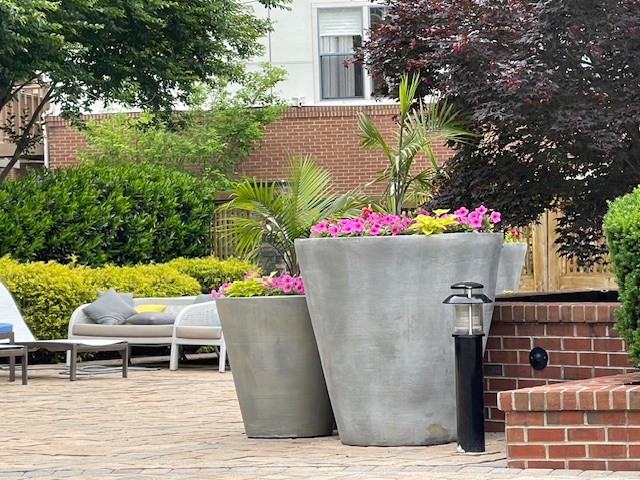When trees become hazardous, diseased, or interfere with your property development plans, professional tree removal becomes necessary to protect your family, property, and community. WC Landscape provides expert tree removal services throughout Centreville, VA, combining advanced safety protocols, specialized equipment, and 40+ years of combined industry experience to handle tree removal projects of any size or complexity. Our certified arborists and trained removal specialists understand the unique challenges presented by Northern Virginia's diverse tree species, varying soil conditions, and local regulations, ensuring every removal project is completed safely, efficiently, and in full compliance with Centreville's municipal requirements and HOA guidelines.



Homeowners in Centreville face various situations requiring professional tree removal, from storm-damaged trees threatening structures to healthy trees that have outgrown their location or interfere with home improvements and landscaping plans.
Our residential tree removal services address:
Tight Space Removals: Many Centreville neighborhoods feature homes with limited yard space, mature landscaping, and proximity to structures. Our team specializes in precision removal techniques that protect surrounding plants, hardscaping, and buildings.
Heritage Tree Considerations: When removal of significant trees becomes necessary, we provide documentation and replacement planning to maintain your property’s landscape character and comply with any local tree preservation ordinances.
HOA Compliance Management: Centreville communities like Virginia Run, Centre Ridge, and Sully Station have specific tree removal policies. We handle permit applications and ensure all work meets community standards.
Business properties, office complexes, and commercial developments in Centreville require professional tree removal services that minimize disruption to operations while maintaining safety and aesthetic standards.
Severe weather events, including thunderstorms, ice storms, and occasional hurricanes that affect Northern Virginia, can create immediate tree removal emergencies requiring rapid professional response.
Different tree species, sizes, and locations require specific removal approaches to ensure safety and prevent property damage during the removal process.
Crane-Assisted Removal: For large trees near structures or in confined spaces, we utilize professional crane services to safely remove tree sections without ground impact damage.
Sectional Dismantling: Large trees are carefully dismantled in manageable sections, with each piece lowered safely using rigging systems that prevent ground damage.
Directional Felling: In open areas where space permits, trees are felled using precise directional techniques that control the fall path and minimize ground impact.
Climbing and Rigging Systems: Certified arborists use professional climbing gear and rigging equipment to access and remove trees in challenging locations.
Stump Grinding Integration: Complete removal services include stump grinding to eliminate root systems and prepare areas for new landscaping or construction.
Northern Virginia's diverse tree population includes both native species and introduced varieties that may require removal due to various factors, including disease susceptibility, growth characteristics, or environmental changes.
Centreville's climate and urban environment create conditions that promote various tree diseases and pest problems, sometimes requiring tree removal when treatment options are ineffective.
Professional tree removal involves significant safety risks that require specialized training, equipment, and protocols to protect workers, property owners, and the surrounding community.
Personal Protective Equipment: All crew members utilize professional-grade safety equipment, including helmets, eye protection, cut-resistant clothing, and fall protection systems when working at height.
Equipment Safety Protocols: Chainsaws, rigging equipment, and heavy machinery receive regular maintenance and safety inspections. Operators maintain current certifications for all specialized equipment.
Site Safety Management: Before beginning any removal project, our team establishes safety perimeters, identifies potential hazards, and implements protection measures for nearby structures and utilities.
Emergency Response Procedures: All crew members receive training in emergency response procedures, first aid, and communication protocols for coordinating with emergency services if needed.
Centreville tree removal projects must comply with various local regulations, HOA requirements, and environmental protection standards that protect community interests and preserve important landscape features.
Tree Removal Permits: Certain tree species, sizes, or locations may require permits from Fairfax County before removal can proceed. We handle all permit applications and ensure compliance with local ordinances.
Heritage Tree Protection: Significant trees may be protected under local heritage tree ordinances, requiring special procedures or replacement plantings.
Environmental Compliance: Projects near wetlands, streams, or other sensitive environmental areas must comply with state and federal environmental protection requirements.
Utility Coordination: Tree removals near power lines, gas lines, or other utilities require coordination with utility companies and may need special permits or procedures.
Every tree removal project begins with a thorough assessment by our certified arborists to determine the best approach for safe, efficient removal while minimizing impact on your property.
Tree Health Evaluation: Our arborists examine tree structure, disease indicators, pest damage, and overall health to confirm removal necessity and identify any special considerations.
Site Analysis: We evaluate surrounding structures, utilities, landscaping, and access routes to develop the safest removal strategy for your specific situation.
Permit Research: Our team identifies any permit requirements based on tree species, size, location, and local regulations, handling all application processes.
Risk Assessment: We identify potential hazards, including overhead wires, nearby structures, underground utilities, and environmental factors that could affect removal procedures.
Cost Estimation: Detailed estimates include all aspects of removal, cleanup, stump grinding, and any additional services required for complete project completion.
Based on our assessment, we develop detailed removal plans that prioritize safety while protecting your property and surrounding landscape features.
Equipment Staging: We coordinate equipment delivery and staging to minimize lawn damage while ensuring efficient access for removal operations.
Utility Location: Professional utility location services identify underground lines, and we coordinate with utility companies regarding any overhead line concerns.
Protection Installation: Surrounding plants, structures, and hardscaping receive protective covering or barriers to prevent damage during removal operations.
Access Route Planning: We establish safe access routes for equipment and crew members while minimizing impact on your landscape and neighboring properties.
Weather Monitoring: Removal operations are scheduled based on weather conditions to ensure safety and optimal working conditions.
Our experienced crew executes removal plans using proven techniques and professional equipment to ensure safe, efficient tree removal with minimal property impact.
Safety Perimeter Establishment: Work areas are secured with appropriate barriers and warning signs to protect residents and visitors during removal operations.
Systematic Dismantling: Trees are removed in carefully planned sections, starting from the top and working downward to maintain control throughout the process.
Rigging and Lowering: Tree sections are safely lowered using professional rigging systems that prevent ground impact damage and allow precise placement.
Debris Management: All tree material is immediately processed and removed from your property, leaving work areas clean and accessible.
Damage Prevention: Throughout removal operations, our crew takes active measures to protect surrounding vegetation, structures, and landscape features.
Complete tree removal includes elimination of the stump and root system, followed by site preparation for your intended future use.
Professional Grinding Equipment: We utilize commercial-grade stump grinders that eliminate stumps below ground level, removing the entire visible portion and major root flare.
Root System Management: Large surface roots are ground below grade to prevent future sprouting and eliminate tripping hazards.
Debris Removal: All grinding debris is removed from your property unless you prefer to use wood chips for mulching or other landscape applications.
Grade Restoration: Stump removal areas are backfilled with quality topsoil and graded to match the surrounding terrain for seamless integration.
Seed or Sod Installation: If desired, we can complete site restoration with grass seed or sod installation to immediately restore lawn areas.
Every tree removal project concludes with thorough cleanup and final inspection to ensure your complete satisfaction with the results.
Debris Removal: All tree material, including branches, logs, and wood chips, is removed from your property and properly disposed of or recycled.
Lawn Restoration: Any lawn areas impacted by equipment are restored through seeding, sodding, or other appropriate repair methods.
Damage Assessment: We conduct final inspections to identify and address any unintended damage to surrounding landscape features or structures.
Site Preparation: Removal areas are prepared according to your plans, whether for new plantings, lawn restoration, or construction projects.
Quality Verification: Our project managers conduct final walkthroughs with homeowners to ensure all work meets our quality standards and customer expectations.
Recognizing when trees pose safety risks requires understanding various warning signs that indicate structural problems or declining health that could lead to failure.
Trees affected by disease, pest infestations, or environmental stress may require removal when treatment options are ineffective or economically impractical.
Healthy trees sometimes require removal for property development, landscape improvements, or compatibility issues with intended property use.
Safe, efficient tree removal requires specialized equipment operated by trained professionals who understand proper techniques and safety protocols.
Modern tree removal incorporates advanced safety technology and techniques that reduce risks while improving efficiency and precision.
Tree removal costs vary significantly based on numerous factors, including tree size, location, complexity, and additional services required for complete project completion.
Professional tree removal provides various benefits that extend beyond immediate safety concerns to include property value, liability management, and future landscape development opportunities.
WC Landscape provides flexible payment options to make necessary tree removal services accessible regardless of your budget constraints or timing preferences.
Responsible tree removal includes consideration of environmental impacts and implementation of practices that minimize ecological disruption while supporting long-term landscape health.
When tree removal creates opportunities for new plantings, professional guidance helps select species that provide maximum benefits while avoiding problems that led to the original tree removal.
While tree removal can be performed year-round when safety concerns require immediate action, certain seasons offer advantages for planned removal projects based on tree biology, weather conditions, and practical considerations.
Centreville's variable weather patterns throughout the year create specific safety considerations that influence removal timing and techniques.
Tree removal permit requirements in Centreville depend on several factors, including tree size, species, location, and local regulations. Fairfax County regulates tree removal in certain situations, and many HOAs have additional requirements.
Tree removal involves significant safety risks that require professional training, specialized equipment, and extensive experience to manage safely. DIY tree removal attempts frequently result in serious injuries, property damage, and legal liability.
WC Landscape offers several options for handling wood material generated during tree removal, allowing you to choose the approach that best fits your needs and preferences.
Tree removal timeframes vary significantly based on tree size, location complexity, weather conditions, and additional services required for complete project completion.
Professional tree removal techniques minimize damage to surrounding landscape features, but some impact is sometimes unavoidable depending on tree size, location, and removal complexity.